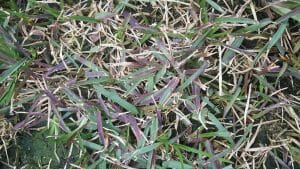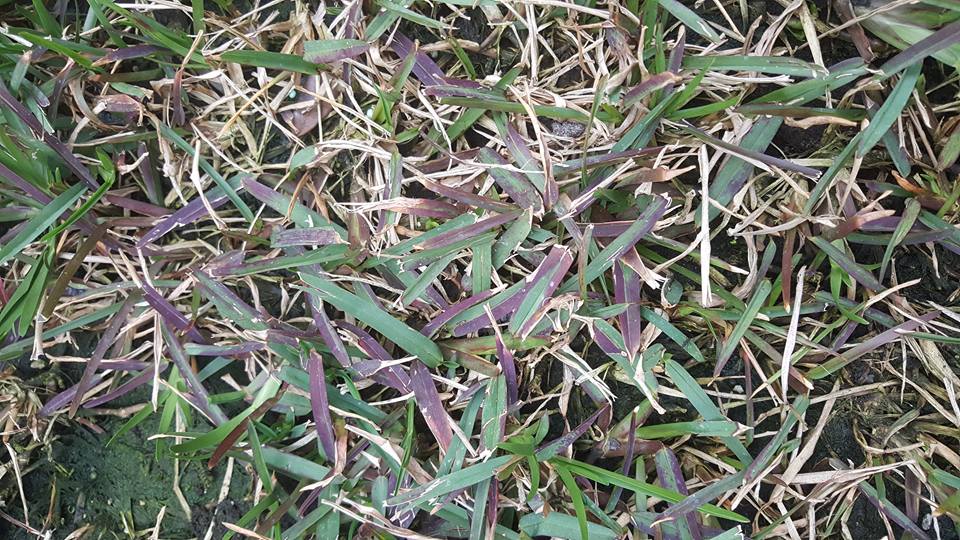It may come as a surprise and even concerning to see your new grass turning purple when its natural color is typically green.
Some ornamental grasses are purple, but that’s mostly not the case as the grass on your lawn should be green, so it’s understandable to ask why is new grass turning purple?
Grass turning purple can be caused by cold weather or nutrient deficiencies. When it happens during warm seasons when the cold isn’t a factor, you are likely not fertilizing your lawn enough, or the grass is not watered well. Diseases can also be a reason for grass turning purple.
You should always consider a purple lawn as a red flag, and understanding the cause is vital in rectifying it. Therefore, until you rule out any problem, proceed with caution.
Why Is New Grass Turning Purple?

New grass will turn purple for different reasons that you must uncover before fixing the problem.
Here are some causes for new grass to turn purple:
1. Cold Weather Stress
Excessive cold can make new grass to turn purple, with the discoloration in grass appearing uniformly sometimes but often in patches. The cold or cooler temperatures trigger this discoloration.
Bermuda grass turning purple when the temperatures become cooler is a common occurrence and will turn back to its natural green color when the cold season comes to an end.
Read more: Why is my grass different shades of green
Cold temperatures impair the grasses’ ability to absorb phosphorus, resulting in a color change.
The freezing weather combined with lack of water puts stress on your grass, and that could be the reason for bermuda grass blades turning purple.
Since you cannot control the weather, the best solution for purpling grass due to the cold is to wait it out.
Buffalo grass turning purple during cooler seasons is common among many varieties of this grass. However, you can avoid this problem by choosing Sir Walter since it’s explicitly designed to keep its color when it gets frosty.
Sir Walter can become dormant in winter, losing some of its color if you plant it in an area with a cool climate. However, don’t worry because it will go back to normal when spring comes and it gets warmer at night.
2. Nutrient Deficiencies
If grass is not getting enough of certain nutrients, such as phosphorus or potassium, it may turn purple. This is because these nutrients are important for the production of chlorophyll, which gives plants their green color. Without enough chlorophyll, the plant may develop a purple tint.
3. Diseases
Purple is usually a sign of stress which can be caused by different things, including disease invasion. Seeing your young grass fall victim and succumb to the effects of the disease is saddening and frustrating.
Some diseases can leave your grass looking unsightly. For instance, leaf spot is a grass fungus caused by Bipolaris sorokiniana, distinguished by brown and purple spots appearing on the grass blades.
Read more: New sod turning brown
If you don’t treat diseases on your grass, they can become more destructive, travelling down to the roots making them rot, killing the grass, and thinning out your lawn.
This fungal disease causes spots with purplish-black borders and makes the crowns and roots change into a dark brown to black color.
Leaf spot is a common disease that can destroy your zoysia grass and could be the reason for your zoysia grass blades turning purple.
Keep in mind that diseases favor periods of humid, warm weather. Moreover, the presence of pests will stress your lawn and transmit diseases.
How To Fix New Grass Turning Purple
The appropriate solution for purpling new grass depends on what is causing it. If the issue is caused by weather conditions (cold), there’s not much you can do but wait for favorable conditions to come back, so wait for winter and fall to pass, and your lawn will be restored to normal.
If phosphorus deficiency is the issue, apply fertilizer to your lawn to ensure your grass receives sufficient nutrients.
However, be careful not to use excess lawn food and cause other problems, so it’s best to conduct a soil test and follow the instructions provided by the manufacturer
In addition, make sure you water your grass adequately, preferably early in the morning, and regularly mow your grass.
Treat lawn diseases with a high-quality fungicide to rid your lawn of the infestation causing your new grass to turn purple. Applying nitrogen could also reduce stress.
Purple Fountain Grass Turning Brown
Fountain grass is a common warm season ornamental grass that you can grow easily on most sites. Your purple fountain grass can turn brown for several reasons- excess fertilizer, searing sunlight burning the grass, pot-bound plants, and overwatering.
It’s also common for this grass’s previous season’s growth to turn brown once the growing season ends.
Trimming fountain grass is necessary to boost its appearance and let the growth in spring shine without a dead blades’ frame.
Frequently Asked Questions
Why Is My Lawn Turning Purple?
Your lawn turning purple occurs for multiple reasons, occurring individually or together. These reasons are diseases, cool or cold temperatures, and nutrient deficiencies.
Why Is My Fescue Grass Turning Purple?
Your fescue grass is turning purple because of heat stress. This grass is least happy during summer when it’s hot and dry.
Why are the tips of my St Augustine grass blades purple?
The dark purple color of your St. Augustine’s grass blades tips is a reaction to the stress of cold water. The warm-season grass doesn’t do well in freezing weather.
Conclusion
It’s incredibly frustrating when your new grass starts to turn purple. But that shouldn’t worry you because purple color is the grass’s natural reaction to cold weather stress.
Purple may be a pleasant color, but not when it taints your lawn’s natural green color and affects its appearance, let alone compromise its health. I hope this guide helps you uncover the cause of your new grass turning purple and fix the problem.
Reference
- University of Minnesota – False spring, false colors: What does purple turf mean?
- Iowa State University – PURPLE DISCOLORATION OF CREEPING BENTGRASS IN THE FALL

Hey there, I’m Derek Schew, a writer for Lawnholic.com, where we cover everything and anything related to lawns. As someone who’s spent countless hours tending to my own lawn, I’m passionate about sharing my knowledge and helping others achieve the perfect yard. From lawn care tips to product reviews, I’m committed to providing our readers with the most accurate and up-to-date information available. So whether you’re a seasoned lawn enthusiast or just getting started, I invite you to join our community and discover the joys of a lush, green lawn.

